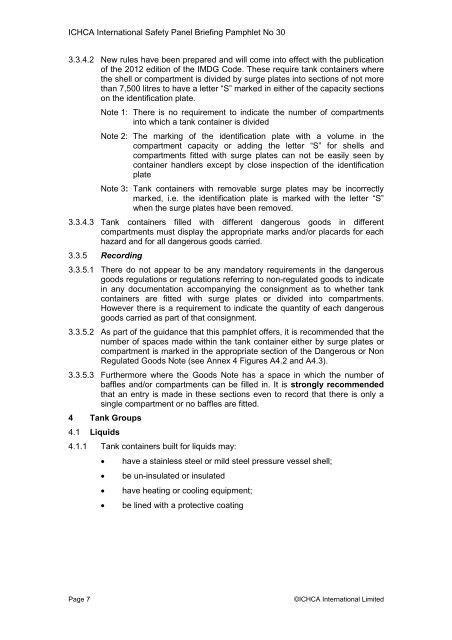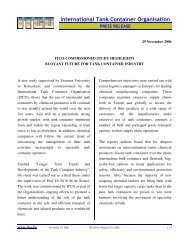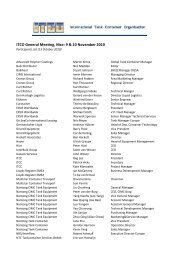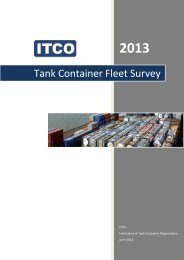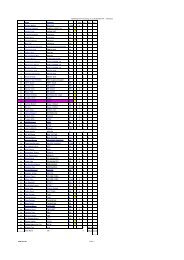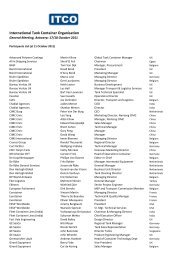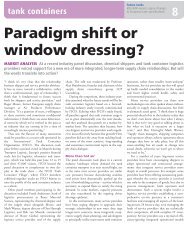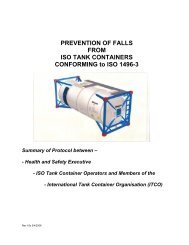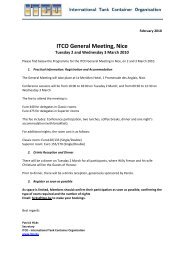You also want an ePaper? Increase the reach of your titles
YUMPU automatically turns print PDFs into web optimized ePapers that Google loves.
ICHCA International <strong>Safe</strong>ty Panel Briefing Pamphlet No 30<br />
3.3.4.2 New rules have been prepared and will come into effect with the publication<br />
<strong>of</strong> the 2012 edition <strong>of</strong> the IMDG Code. These require tank containers where<br />
the shell or compartment is divided by surge plates into sections <strong>of</strong> not more<br />
than 7,500 litres to have a letter “S” marked in either <strong>of</strong> the capacity sections<br />
on the identification plate.<br />
Note 1: There is no requirement to indicate the number <strong>of</strong> compartments<br />
into which a tank container is divided<br />
Note 2: The marking <strong>of</strong> the identification plate with a volume in the<br />
compartment capacity or adding the letter “S” for shells and<br />
compartments fitted with surge plates can not be easily seen by<br />
container handlers except by close inspection <strong>of</strong> the identification<br />
plate<br />
Note 3: <strong>Tank</strong> containers with removable surge plates may be incorrectly<br />
marked, i.e. the identification plate is marked with the letter “S”<br />
when the surge plates have been removed.<br />
3.3.4.3 <strong>Tank</strong> containers filled with different dangerous goods in different<br />
compartments must display the appropriate marks and/or placards for each<br />
hazard and for all dangerous goods carried.<br />
3.3.5 Recording<br />
3.3.5.1 There do not appear to be any mandatory requirements in the dangerous<br />
goods regulations or regulations referring to non-regulated goods to indicate<br />
in any documentation accompanying the consignment as to whether tank<br />
containers are fitted with surge plates or divided into compartments.<br />
However there is a requirement to indicate the quantity <strong>of</strong> each dangerous<br />
goods carried as part <strong>of</strong> that consignment.<br />
3.3.5.2 As part <strong>of</strong> the guidance that this pamphlet <strong>of</strong>fers, it is recommended that the<br />
number <strong>of</strong> spaces made within the tank container either by surge plates or<br />
compartment is marked in the appropriate section <strong>of</strong> the Dangerous or Non<br />
Regulated Goods Note (see Annex 4 Figures A4.2 and A4.3).<br />
3.3.5.3 Furthermore where the Goods Note has a space in which the number <strong>of</strong><br />
baffles and/or compartments can be filled in. It is strongly recommended<br />
that an entry is made in these sections even to record that there is only a<br />
single compartment or no baffles are fitted.<br />
4 <strong>Tank</strong> Groups<br />
4.1 Liquids<br />
4.1.1 <strong>Tank</strong> containers built for liquids may:<br />
have a stainless steel or mild steel pressure vessel shell;<br />
be un-insulated or insulated<br />
have heating or cooling equipment;<br />
be lined with a protective coating<br />
Page 7 ©ICHCA International Limited


